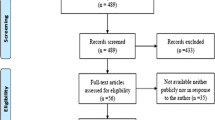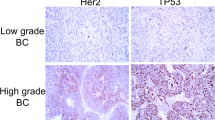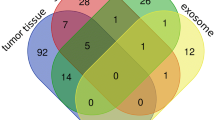Abstract
MicroRNAs (miRNAs) have recently been shown to down-regulate gene expression by targeting mRNA translation and to play a critical role in tumorigenesis; how they regulate bladder tumor development, particularly in patients, is, however, poorly understood. The difference in miRNA expression in a bladder tumor compared with healthy tissue from the same patients was examined using microRNA arrays in seven patients. Here, we showed that up-regulation of miRNA was not commonly found in this limited number of patients, and four miRNAs (miR-26a, miR-29c, miR-30c, miR-30e-5p) were down-regulated as a common marker in patients with a 1–3 grade of disease. Our data suggest that instead of up-regulation of carcinogenic miRNAs, loss of regulation of these miRNA may be critical for bladder tumor development in patients.


Similar content being viewed by others
References
Yang L, Parkin DM, Li LD, Chen YD, Bray F (2004) Estimation and projection of the national profile of cancer mortality in China: 1991–2005. Br J Cancer 90:2157–2166
Knowles MA (2006) Molecular subtypes of bladder cancer: Jekyll and Hyde or chalk and cheese? Carcinogenesis 27:361–373. doi:10.1093/carcin/bgi310
Sobin L, Wittekind C (2002) UICC: TNM classification of malignant tumors, 6th edn. Wiley–Liss, New York
Takahashi R, Hashimoto T, Xu HJ et al (1991) The retinoblastoma gene functions as a growth and tumor suppressor in human bladder carcinoma cells. Proc Natl Acad Sci USA 88:5257–5261. doi:10.1073/pnas.88.12.5257
Lamy A, Gobet F, Laurent M et al (2006) Molecular profiling of bladder tumors based on the detection of FGFR3 and TP53 mutations. J Urol 176:2686–2689. doi:10.1016/j.juro.2006.07.132
Ambros V (2001) MicroRNAs: tiny regulators with great potential. Cell 107:823–826. doi:10.1016/S0092-8674(01)00616-X
Shivdasani RA (2006) MicroRNAs: regulators of gene expression and cell differentiation. Blood 108:3646–3653. doi:10.1182/blood-2006-01-030015
Good L (2003) Translation repression by antisense sequences. Cell Mol Life Sci 60:854–861
Bartel DP (2004) MicroRNAs: genomics, biogenesis, mechanism, and function. Cell 116:281–297. doi:10.1016/S0092-8674(04)00045-5
Cimmino A, Calin GA, Fabbri M et al (2005) miR-15 and miR-16 induce apoptosis by targeting BCL2. Proc Natl Acad Sci USA 102:13944–13949. doi:10.1073/pnas.0506654102
Hwang HW, Mendell JT (2006) MicroRNAs in cell proliferation, cell death, and tumorigenesis. Br J Cancer 94:776–780. doi:10.1038/sj.bjc.6603023
Tong AW, Nemunaitis J (2008) Modulation of miRNA activity in human cancer: a new paradigm for cancer gene therapy? Cancer Gene Ther 15:341–355. doi:10.1038/cgt.2008.8
Lagos-Quintana M, Rauhut R, Yalcin A, Meyer J, Lendeckel W, Tuschl T (2002) Identification of tissue-specific microRNAs from mouse. Curr Biol 12:735–739. doi:10.1016/S0960-9822(02)00809-6
Papagiannakopoulos T, Kosik KS (2008) MicroRNAs: regulators of oncogenesis and stemness. BMC Med 6:15. doi:10.1186/1741-7015-6-15
Fabbri M, Croce CM, Calin GA (2008) MicroRNAs. Cancer J 14:1–6. doi:10.1097/PPO.0b013e318164145e
Sood P, Krek A, Zavolan M, Macino G, Rajewsky N (2006) Cell-type-specific signatures of microRNAs on target mRNA expression. Proc Natl Acad Sci USA 103:2746–2751. doi:10.1073/pnas.0511045103
Dillhoff M, Wojcik SE, Bloomston M (2008) MicroRNAs in solid tumors. J Surg Res. doi:10.1016/j.jss.2008.02.046
Gottardo F, Liu CG, Ferracin M et al (2007) Micro-RNA profiling in kidney and bladder cancers. Urol Oncol 25:387–392. doi:10.1016/j.urolonc.2007.01.019
Chen C, Ridzon DA, Broomer AJ et al (2005) Real-time quantification of microRNAs by stem-loop RT-PCR. Nucleic Acids Res 33:e179. doi:10.1093/nar/gni178
Akao Y, Nakagawa Y, Naoe T (2006) MicroRNAs 143 and 145 are possible common onco-microRNAs in human cancers. Oncol Rep 16:845–850
Fabbri M, Garzon R, Cimmino A et al (2007) MicroRNA-29 family reverts aberrant methylation in lung cancer by targeting DNA methyltransferases 3A and 3B. Proc Natl Acad Sci USA 104:15805–15810. doi:10.1073/pnas.0707628104
Sengupta S, den Boon JA, Chen IH et al (2008) MicroRNA 29c is down-regulated in nasopharyngeal carcinomas, up-regulating mRNAs encoding extracellular matrix proteins. Proc Natl Acad Sci USA 105:5874–5878. doi:10.1073/pnas.0801130105
Visone R, Pallante P, Vecchione A et al (2007) Specific microRNAs are downregulated in human thyroid anaplastic carcinomas. Oncogene 26:7590–7595. doi:10.1038/sj.onc.1210564
Chang TC, Yu D, Lee YS et al (2008) Widespread microRNA repression by Myc contributes to tumorigenesis. Nat Genet 40:43–50. doi:10.1038/ng.2007.30
Wong CF, Tellam RL (2008) MicroRNA-26a targets the histone methyltransferase enhancer of Zeste homolog 2 during myogenesis. J Biol Chem 283:9836–9843. doi:10.1074/jbc.M709614200
Takamizawa J, Konishi H, Yanagisawa K et al (2004) Reduced expression of the let-7 microRNAs in human lung cancers in association with shortened postoperative survival. Cancer Res 64:3753–3756. doi:10.1158/0008-5472.CAN-04-0637
Akao Y, Nakagawa Y, Naoe T (2006) let-7 microRNA functions as a potential growth suppressor in human colon cancer cells. Biol Pharm Bull 29:903–906. doi:10.1248/bpb.29.903
Mayr C, Hemann MT, Bartel DP (2007) Disrupting the pairing between let-7 and Hmga2 enhances oncogenic transformation. Science 315:1576–1579. doi:10.1126/science.1137999
Johnson SM, Grosshans H, Shingara J et al (2005) RAS is regulated by the let-7 microRNA family. Cell 120:635–647. doi:10.1016/j.cell.2005.01.014
Inamura K, Togashi Y, Nomura K et al (2007) let-7 microRNA expression is reduced in bronchioloalveolar carcinoma, a non-invasive carcinoma, and is not correlated with prognosis. Lung Cancer 58:392–396. doi:10.1016/j.lungcan.2007.07.013
Zhu S, Si ML, Wu H, Mo YY (2007) MicroRNA-21 targets the tumor suppressor gene tropomyosin 1 (TPM1). J Biol Chem 282:14328–14336. doi:10.1074/jbc.M611393200
Lu Z, Liu M, Stribinskis V, Klinge CM, Ramos KS, Colburn NH, Li Y (2008) MicroRNA-21 promotes cell transformation by targeting the programmed cell death 4 gene. Oncogene 27:4373–4379. doi:10.1038/onc.2008.72
Meng F, Henson R, Wehbe-Janek H, Ghoshal K, Jacob ST, Patel T (2007) MicroRNA-21 regulates expression of the PTEN tumor suppressor gene in human hepatocellular cancer. Gastroenterology 133:647–658. doi:10.1053/j.gastro.2007.05.022
Zhu S, Wu H, Wu F, Nie D, Sheng S, Mo YY (2008) MicroRNA-21 targets tumor suppressor genes in invasion and metastasis. Cell Res 18:350–359. doi:10.1038/cr.2008.24
Tavazoie SF, Alarcón C, Oskarsson T et al (2008) Endogenous human microRNAs that suppress breast cancer metastasis. Nature 451:147–152. doi:10.1038/nature06487
Acknowledgments
The authors would like to thank Dr Guangdi Chen (Department of Dermatology and Skin Science, University of British Columbia) for reading the manuscript and editing the graphs, and Mr Robert H. Bell (Bioinformatics Group, Prostate Centre, Vancouver General Hospital) for his assistance with the analysis of miRNA expression profiles. This study was supported by a grant from the Hangzhou Science–Technology Development Program (No. 20043259) (Hangzhou, Zhejiang, P.R. China) (G. Wang) and by start-up funding from the University of British Columbia (C. Du).
Author information
Authors and Affiliations
Corresponding authors
Rights and permissions
About this article
Cite this article
Wang, G., Zhang, H., He, H. et al. Up-regulation of microRNA in bladder tumor tissue is not common. Int Urol Nephrol 42, 95–102 (2010). https://doi.org/10.1007/s11255-009-9584-3
Received:
Accepted:
Published:
Issue Date:
DOI: https://doi.org/10.1007/s11255-009-9584-3




